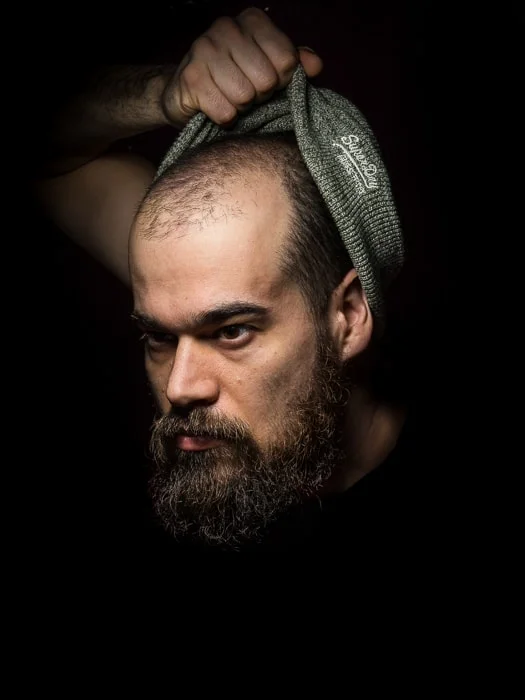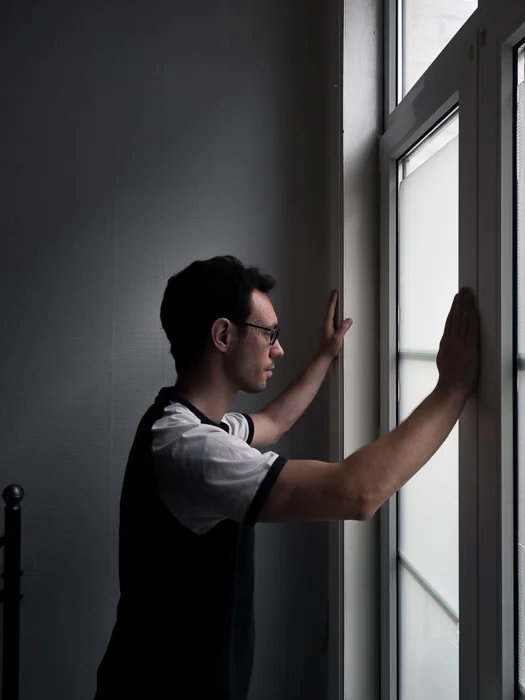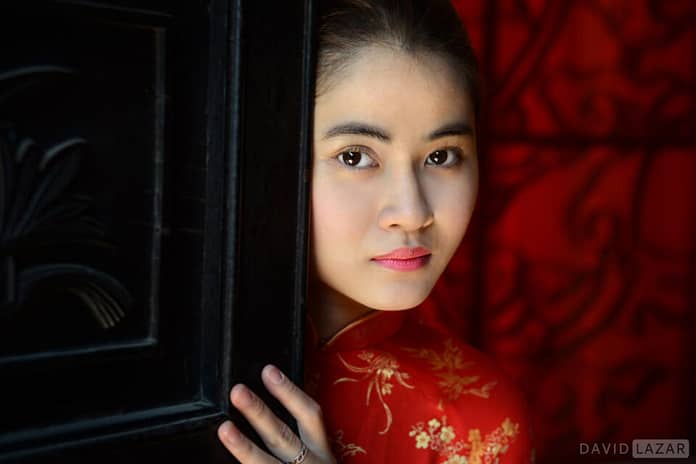Portrait Lighting can either make or break your photos. The wrong light can make your subject look flat and uninteresting.
To make your photos interesting, here are the most essential studio lighting techniques.
This article will also offer you some portrait lighting tips to help you along as you go.

Natural Light vs. Studio Portrait Lighting
Often, the whole ‘portrait lighting setup’ thing can be intimidating for beginners. Most will think that working with ambient light will be easier.
This, unfortunately, is not always the case. Dedicated artificial lights have some important advantages:
- They allow you to be much more flexible and creative in lighting your model.
- They give you more control over exposure than ambient light.

For correct exposure, you have to match your camera settings to the ambient light. Even when mixing on-camera flash and ambient light.
The risk is that you may end up using too slow of a shutter speed, particularly if you do not have fast f/1.4-2.8 lenses.
With artificial lights, instead, you can set your aperture, ISO and shutter speed as you like. My go-to settings are f/8, ISO 200 and 1/125. And then you can adjust the light power to suit your needs.
It’s easier and I find that I can shoot with any lens available on the market. Cheap kit lenses included.

If you are not familiar with studio equipment, have a look at this article about creating a home studio.
How to Use Light
When it comes to portrait lighting, there’s soft and hard light.
A hard light casts strong, dark and defined shadows. Soft light produces lighter shadows. There’s a more gradual transition between dark and bright areas of the image.
What makes portrait photography lighting hard or soft is not its source. It’s the ratio between the apparent size of its source compared to that of the subject.
A bare flashgun will produce a harder light when you photograph people.

Light modifiers will soften the flashlight. You can use umbrellas, softboxes, or a flash bounced off a white wall.

The last thing to know about light is that its intensity decays following the inverse square law.
Say the distance between the light source and the subject doubles. Every time this happens, the light intensity on the subject decreases by a factor of four.
This property results in ‘light fall-off’. This is an effect often used in portraiture to better control the light pattern on your model.
How to Use Single Light Setups
Working with a single light source is a great way to learn classic lighting patterns. It also allows you to concentrate more on the artistic side of portraiture.
You’ll find a downloadable cheatsheet below. It shows the most popular classic portrait lighting setups.
These are:
- split lighting;
- loop lighting;
- butterfly lighting;
- Rembrandt lighting;
- rim lighting;
- and silhouette lighting.
This great glossary for portrait photography terms has all the explanations you need.
Single Light Setup Cheatsheet

Every portrait lighting setup creates a distinct light pattern on your model. This depends on the specific position of the light relative to the model’s nose.
The position of the camera will affect the face lighting-to-shadow ratio.


Using Multiple Light Setups
This is how professional portrait photographers make studio portraits. More subtle and complicated light patterns are possible with several lights.
With more than one light, you can also separate your model from the background.

The various lights in such setups get their names from their function:
- Key light -The main light for the scene. It determines the light pattern. And it is the first number listed in lighting ratios (e.g. in a lighting ratio of 4:1, the key light is the no. 4).
- Fill lights– Used to fill (lighten) the shadows, fill lights are generally weaker than the key light. This is the second number listed in lighting ratios (e.g. in a lighting ratio of 4:1, the fill light is the no. 1).
- Hair/separation/rim lights – These lights keep your model from blending in with the background. They are usually placed to the side, behind the model. And they highlight parts of his/her figure and contours.
- Background light – A background light is particularly useful for high-key portraits. You can also use it as a separation light in light setups with several lights. Or, together with some coloured gels, it can alter the colour of the background.
Several lights also make it easy to alter the contrast in the image. They change the ratio of light between the key light and the fill lights.
High contrast images, with a key-to-fill lighting ratio of 8:1 or more, best suit male models. More balanced ratios such as 4:1 or 3:1 or less are more appropriate for female models.
Keep in mind that these are guidelines. In photography, bending or breaking the rules is acceptable.
The Most Common Portrait Lighting Patterns
Let’s see how to put in practice the basic concepts discussed above. We’ll consider a few typical light patterns.
Split and ‘Hero’ Lighting
This high contrast light pattern is often used to create portraits in a low key style.

Split lighting is the quintessential example of side lighting. It’s also the simplest of all lighting setups.
Line up a single, bare, flash with your model’s shoulder, and take the photo from in front of your model.

An interesting variation occurs when you mirror the flash setup, as in the scheme below.
This creates the so-called ‘hero lighting’ pattern.

This setup takes its name from the powerful mood it conveys. It produces a strong shadow in the middle of your model’s face.
Control the shadow’s thickness by positioning the model in front of the lights. This creates a larger shadow.
Position the model behind the lights for a thinner shadow.

Loop Lighting
Every article on flash portraiture proposes this simple one-light setup. It suits both male and female models.
Particularly if you use a light modifier, such as an umbrella or a softbox, to create soft light.

To keep your model from blending in with the background you can add a separation light. This creates the most classic of the two-light setups.

If you are after a more punchy look and feel, try replacing your umbrella with a grid. This produces a tighter splash of light.
Butterfly and Clamshell Lighting
Butterfly lighting was very popular in the ’30s among Hollywood photographers. It casts a small, butterfly-shaped shadow cast under the model’s nose.
When shooting a female model, use an umbrella or a softbox to soften the light.

This portrait lighting scheme can leave deep shadows. These appear under the model’s chin, cheekbones and nose.

To disperse those shadows add a fill light right under the key light, lighting the model from below.
This is a clamshell setup. It is one of those go-to setups that will never disappoint you.

Usually, the fill light is weaker than the key light to leave some gentle shadows. It can be either a reflector or a second flashgun (set to a lower power than the key light).

Working With Rim Lighting
You can use rim light to create images with a dark, mysterious, and sometimes abstract feeling.

You can also use it as a separation light.

Setting this up is a no-brainer. Hide a flashgun behind the model to light him/her from behind.
If you want to highlight a complete figure you need two lights. One at either side of your model, pointing back at them.

To have a nice, thin, rim light highlighting only the contour of your model’s figure, mind your flash power. Too much and the light will spill over the contour and light their anterior side (the front).
Balancing Flash and Ambient Light
When doing flash photography in the studio, we tend to suppress ambient light. This is so it does not affect our portrait lighting setup.
Sometimes though, you may want to combine flash and ambient light.
First meter for the ambient light with aperture, ISO and shutter speed. Then match that reading with your flash.
A flash meter, such as the Sekonic L-308s is a welcome accessory when working with flashlights. Even more so when you are mixing them with ambient light.

Indoor Portraiture With Natural Light
It is possible to do great indoor portraiture by using only natural light coming in from a window.

Of all lighting setups, split lighting is the easiest one to recreate with ambient light.

You can place a reflector on the opposite side of the model (facing the windows).
This works as a fill light to brighten up the shadows and create more balanced images.

When working with ambient light you have to pay attention to the environment you are shooting in. The surroundings will be visible in the image.
Keep that background uncluttered and non-distracting. And use the model’s surroundings to stage the portrait and set its mood.

The real challenge is to keep the shutter speed high. This way your model will look sharp while avoiding underexposing your scene too much.
When to Shoot Low Key and High Key
These two styles dictate the mood of the final image. Some light patterns and subjects work better with low key style. Others deliver better results in high key, depending on what you’re going for.
In a low-key portrait, about 80% of the tones across the image are dark. With the right light, this style conveys a dark, powerful, dramatic, or mysterious mood.

High-key images have most of the tones on the bright side of the scale. This creates a more lively and joyful mood.
It is not by chance that most stock images portraying people are high-key. The same is true for newborn and toddler portraits.

For high-key images you have to light up your background, or else it will come out grey.
You’ll want your background to be white when taking headshots or newborn portraits. Use a large softbox (with a flash inside) or a window as a background.
Conclusion
This post gives you all the info you need to deliver striking portraits. In several different styles.
A last word of advice, though. Don’t get stuck on this or that portrait lighting setup.
These patterns are a starting point for your exploration of lighting. Don’t be afraid to improvise and experiment with your light sources and never forget to have fun.




